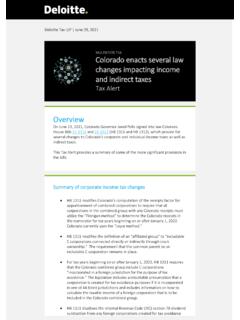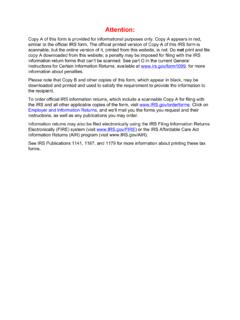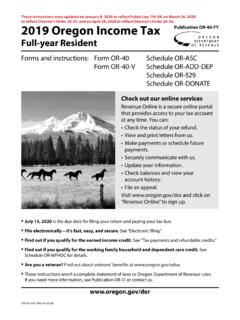Transcription of 2021 Instructions for Schedule K-1 (Form 1041) for a ...
1 Userid: CPMS chema: instrxLeadpct: 100%Pt. size: 9 Draft Ok to PrintAH XSL/XMLF ileid: .. 1041schk-1/2021/a/xml/cycle03/source(Ini t. & Date) _____Page 1 of 4 12:04 - 13-Dec-2021 The type and rule above prints on all proofs including departmental reproduction proofs. MUST be removed before for Schedule K-1 (Form 1041) for a Beneficiary Filing Form 1040 or 1040-SRNote. The fiduciary s Instructions for completing Schedule K-1 are in the Instructions for Form of the TreasuryInternal Revenue ServiceSection references are to the Internal Revenue Code unless otherwise DevelopmentsFor the latest information about developments related to Schedule K-1 (Form 1041) and its Instructions , such as legislation enacted after they were published, go to deductions on termination.
2 Under Final Regulations - TD9918, each excess deduction on termination of an estate or trust retains its separate character as an amount allowed in arriving at adjusted gross income, a non-miscellaneous itemized deduction , or a miscellaneous itemized deduction . Box 11, code A, was revised to read Excess deductions section 67(e) expenses and a new Box 11, code B, Excess deductions Non-miscellaneous itemized deductions was Box 11, Code A Excess Deductions on Termination - section 67(e) Expenses and Box 11, Code B Excess Deductions on Termination-Non-Miscellaneous Itemized Deductions, later, for more interest expense limitation.
3 Every taxpayer who deducts business interest is required to file Form 8990, Limitation on Business Interest Expense Under section 163(j), unless an exception for filing is met. For more information, see Form 8990 and its Instructions . For details, see Code Z, under Box 14 Other information, 's identification number. For your protection, Schedule K-1 may show only the last four digits of your identifying number (social security number (SSN), etc.). However, the estate or trust has reported your complete identifying number to the withholding. If Schedule K-1 shows backup withholding in box 13, code B, attach a copy to your business income deduction .
4 If applicable, a worksheet or statement containing information needed to figure your qualified business income deduction should be attached to your Schedule K-1. For more information, see the Instructions for Form 8995, Qualified Business Income deduction Simplified Computation, or Form 8995-A, Qualified Business Income deduction . Also see Code I. section 199a information, under Box 14 Other information, InstructionsPurpose of FormUse Schedule K-1 to report a beneficiary's share of the estate s or trust s income, credits, deductions, etc. on your Form 1040 or 1040-SR. Keep it for your records.
5 Don t file it with your tax return, unless backup withholding was reported in box 13, code Treatment of ItemsGenerally, you must report items shown on your Schedule K-1 (including attached schedules) the same way that the estate or trust treated the items on its the treatment of an item on your original or amended return is inconsistent with the estate s or trust s treatment (or if the estate or trust was required to but hasn't filed a return), you must file Form 8082, Notice of Inconsistent Treatment or Administrative Adjustment Request (AAR), with your original or amended return to identify and explain any inconsistency (or to note that an estate or trust return hasn't been filed).
6 If you are required to file Form 8082 but fail to do so, you may be subject to the accuracy-related penalty. This penalty is in addition to any tax that results from making your amount or treatment of the item consistent with that shown on the estate s or trust s return. Any deficiency that results from making the amounts consistent may be assessed you believe the fiduciary has made an error on your Schedule K-1, notify the fiduciary and ask for an amended or a corrected Schedule K-1. Don t change any items on your copy. Be sure that the fiduciary sends a copy of the amended Schedule K-1 to the IRS.
7 If you are unable to reach an agreement with the fiduciary regarding the inconsistency, you must file Form you are the executor of an estate and you received a decedent's Schedule K-1 from an estate or trust in which the decedent had a beneficial interest, but the decedent died in a prior year, then you should request that the fiduciary send you a corrected Schedule K-1 to reflect the proper allocation of tax items under the will or the trust's governing of Generation-Skipping TrustsIf you received Form 706-GS(D-1), Notification of Distribution From a Generation-Skipping Trust, and paid a generation-skipping transfer (GST) tax on Form 706-GS(D), Generation-Skipping Transfer Tax Return for Distributions, you can deduct the GST tax paid on income distributions on Schedule A (Form 1040), line 6.
8 To figure the deduction , see the Instructions for Form 706-GS(D).Specific InstructionsPart I Information About the Estate or TrustItem EIf the Item E box is checked, this is the final year of the estate or If the Final K-1 box at the top of Schedule K-1 is checked, this is the final return for the III Beneficiary s Share of Current Year Income, Deductions, Credits, and Other ItemsThe amounts shown in boxes 1 through 14 reflect your share of income, loss, deductions, credits, etc., from an estate or trust. For Form 1040 or 1040-SR filers, page 2 of Schedule K-1 provides summarized reporting information.
9 The summarized reporting information reflects Dec 13, 2021 Cat. No. 11374 ZPage 2 of 4 Fileid: .. 1041schk-1/2021/a/xml/cycle03/source12:0 4 - 13-Dec-2021 The type and rule above prints on all proofs including departmental reproduction proofs. MUST be removed before to forms in use for calendar year If you are not an individual, report the amounts in each box as instructed on your tax In box 9 and boxes 11 through 14, the fiduciary will identify each item by entering a code in the column to the left of the dollar amount entry space. These codes are identified on page 2 of Schedule statements.
10 The fiduciary will enter an asterisk (*) after the code, if any, in the column to the left of the dollar amount entry space for each item for which it has attached a statement providing additional information. For those informational items that cannot be reported as a single dollar amount, the estate or trust will enter an asterisk in the left column and write STMT in the dollar amount entry space to indicate the information is provided on an attached 1 Interest IncomeThis box reports the beneficiary s share of the taxable interest income. This amount is reported on line 2b of Form 1040 or 1040-SR and Schedule B, Part I, line 1, if 2a Ordinary DividendsThis box reports the beneficiary s share of ordinary dividends.












